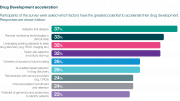European and US pharma companies have welcomed the EMA’s new clinical trials information system (CTIS), according to an Arriello survey. Arriello’s Kieran O’Donnell and Nicola Kidman present the findings of the survey, which was carried out at around the halfway point between the CTR go-live and the mandatory date for compliance with CTIS for new studies.
In the late summer, Arriello commissioned a comprehensive survey of European and US pharma companies’ initial experiences of the EMA’s new centralised clinical trials information system (CTIS). The new platform and portal are designed to streamline the submission, assessment and approval of trials across EU markets, under the new Clinical Trials Regulation (CTR)[1], applicable since the end of January 2022 and mandatory for all new trials from January 31, 2023.
The August 2022 survey, conducted by Censuswide, took place at roughly the halfway point between the CTR go-live and the mandatory date for compliance with CTIS for new studies. The survey findings have proved remarkably upbeat.
Teething troubles
The first surprise was the level of activity already taking place through CTIS by August, given that CTIS use isn’t mandatory until after the end of January 2023. Over 90 per cent of respondents claimed to be already registered in the new centralised system; 40 per cent had used it to submit a clinical trial application (CTA), and just over 17 per cent had applications pending. Overall, 92 per cent of survey participants said their organisation was planning a clinical trial through the centralised EMA system over the coming six months.
Of those that had already registered a trial through the CTIS, more than a third (37 per cent) had found the experience faster/shorter than expected, and 31 per cent said the process had been easier than expected. Biotechs were most likely to be impressed with the speed of using the new system.
Although experiences of the new portal haven’t been pain free, there was no obvious single point of concern. Issues spanned:
- Organisational structure – cited by 38 per cent of all respondents, rising to 43 per cent of US respondents
- Training/information overload – cited by 36 per cent overall, with a contrast between German and Swiss respondents (50 per cent of Germans found this to be a barrier, compared with just 25 per cent of Swiss respondents). CROs were the most likely to have an issue with this.
- Transition point identification – an issue for 35 per cent of all respondents, with Germany, the US and UK more concerned about this than Swiss survey participants (only a quarter of which felt this to be a barrier).
- Fear of the unknown – cited by 33 per cent of all respondents, rising to 38 per cent of German respondents
- A lack of clearly defined process steps – for 33 per cent overall, rising to 39 per cent of German participants.
Traditional pharma organisations were most likely to have encountered issues with organisational structure and transition point identification. Biotechs were not overly concerned with any one pain point.
Intended benefits of the CTIS
All respondents appeared to have a good grasp of the intended benefits of the CTIS, confirmed to include:
- Faster approvals – expected by 35 per cent of all respondents (rising to 40 per cent of US respondents);
- A wider group experience – cited by 33 per cent of all respondents (rising to 50 per cent of consultancies);
- Efficiency of scale – cited by 30 per cent;
- Harmonised processes – 28 per cent;
- Greater transparency – 28 per cent (rising to 40 per cent of US respondents while by contrast falling to 16 per cent of Swiss respondents);
- Fostering of innovation & research – 26 per cent (falling to 16 per cent of Swiss respondents); and
- More uniform decisions – 25 per cent.
Biotechs were most switched on by the potential for accelerated trial approvals. For traditional pharma, harmonised processes, increased transparency, and efficiency of scale were the top three expected benefits.
Attracting sponsors to run clinical studies in Europe
Respondents were asked whether – and to what extent – the new clinical trials review set-up might attract more sponsors to run clinical studies in Europe. The vast majority (81 per cent) of all respondents said they expected a net increase in the volume of sponsored trial activity in Europe, rising to 94 per cent of US respondents.
That so many survey respondents appear to have already registered clinical trials via the new CTIS is surprising, but take-up will undoubtedly increase as the risk of having to transition between systems mid study grows.
The positive initial reception of the CTIS is highly encouraging. Yet, achieving complete harmonisation of clinical trial vetting across Europe’s diverse markets remains a challenge that pharma companies must meet to maximise the potential for clinical studies in Europe.
About the authors
Nicola Kidman is a Principal Consultant, Regulatory Affairs at Arriello and has over 20 years of EU/UK and International regulatory experience gained via positions in pharma, CROs and consultancy companies.
Her expertise spans all aspects of regulatory affairs from early drug development to post marketing support, including clinical trial applications and amendments, clinical development plans, scientific advice, Orphan Drug Applications, Paediatric Investigation Plans, MAAs and life cycle maintenance support.
Kieran O’Donnell is VP of Drug Safety & Principal Consultant for Pharmacovigilance at Arriello, a leading global provider of Regulatory, Quality, Safety/PV and Clinical advisory and managed services.
References
[1] Clinical Trials Regulation, EMA: https://www.ema.europa.eu/en/human-regulatory/research-development/clinical-trials/clinical-trials-regulation





